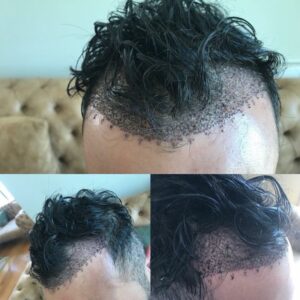
Baldness is a problem faced by a large number of people. According to the American College of Dermatology, up to 50% of men and up to 25% of women over the age of 50 suffer from androgenetic alopecia. Moreover, younger people are increasingly complaining of significant thinning and thinning of their hair. Why does this happen? There are many reasons for the development of alopecia areata. These include:
![]() genetic predisposition;
genetic predisposition;
![]() environmental pollution;
environmental pollution;
![]() the use of harsh cosmetics;
the use of harsh cosmetics;
![]() poor diet and stress.
poor diet and stress.
Often, these factors are combined, and the path to complete baldness becomes very short. Fortunately, modern aesthetic medicine offers an effective solution – hair transplantation. Beauty by Experts Medical has gathered for you all the most relevant information about this technique. This article will teach you what hair transplantation is, what advanced transplantation methods exist, and what results you can expect from them.
What is a hair transplant?
During the surgery, hair from a donor site is transplanted to the area of baldness. The grafts are placed into small channels created in the recipient area using a scalpel or other instrument.
In various hair transplant procedures, follicles are usually taken from the back of the head. This is because they are not affected by dihydrotestosterone in this area. This hormone leads to thinning of hair follicles, thinning and hair loss. Follicles taken from the occipital area retain their genetic characteristics. Therefore, the hair transplanted to the area of baldness will continue to grow despite the effect of hormones. Thus, transplantation allows for permanent results.
What are the different hair transplant procedures?
People have been looking for methods to solve the problem of baldness for a very long time. The first attempts at hair transplantation were made in Japan in the 1930s. The surgical procedure involved transferring a flap of skin from one part of the head to another to cover balding areas. However, the results were imperfect, and the method was unsafe.
In 1959, American Dr. Norman Orentreich developed the FUT hair transplant procedure. It involved removing a strip of tissue from the back of the head, then dividing it into small sections (grafts) and transplanting it into the recipient area. This technique was more advanced and allowed to achieve a good effect. However, it was not without disadvantages. After removing the flap of tissue in the donor area, a noticeable scar was left, which had to be hidden under the hair. In addition, after such a hair transplant procedure, the patient needed a long recovery period.
Transplant methods continued to improve. More than 30 years of evolution in surgical hair restoration resulted in the FUE (Follicular Unit Extraction) technique and its modifications. We will look at them separately to understand how these techniques differ from previous ones. But first, let’s elaborate a bit more on the term graft.
What is a graft in hair transplantation?
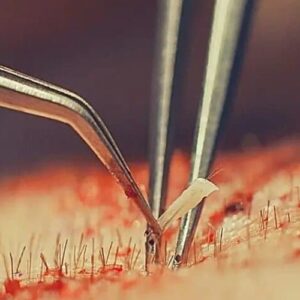 From a medical point of view, a graft is a section of living tissue surgically transplanted. But what is a graft or a graft in modern hair transplant procedures? In this case, we are talking about a follicular unit.
From a medical point of view, a graft is a section of living tissue surgically transplanted. But what is a graft or a graft in modern hair transplant procedures? In this case, we are talking about a follicular unit.
For many years, it was believed that the hair on the head grew individually. It was not until 1995 that physician Bernard Axerold discovered that this was not the case. Hair grows in small groups of several hair follicles (1 to 4). These groups have been called follicular units. It is pretty challenging to see them with the naked eye. However, if you cut your hair short and examine the scalp closely with a special densitometer, these structural units become clearly visible.
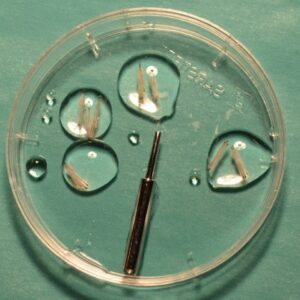 In addition to hair follicles, the follicular unit contains nerves, blood vessels and muscle fibres that lift the hair. A collagen capsule on top surrounds it.
In addition to hair follicles, the follicular unit contains nerves, blood vessels and muscle fibres that lift the hair. A collagen capsule on top surrounds it.
Thus, follicular units are complete anatomical and physiological structures. This is the reason for the engraftment and growth of new hair after transplantation.
The transfer of follicular units (FUEs) rather than larger scalp sections has revolutionized the field of surgical hair restoration. The main advantage of this approach is the ability to achieve good hair density.
Another important consideration is the number of grafts that can be transplanted. Regarding the FUE hair transplant procedure, grafts refer to follicular units containing several hair follicles. So, a transplant of 100 grafts usually involves the transfer of 200 to 400 hairs.
What is a FUE hair transplant?
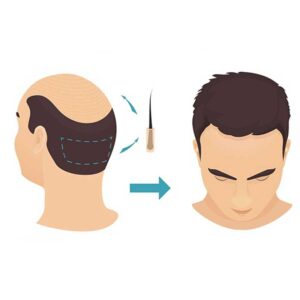 Before surgery, the donor area on the back of the head is shaved to facilitate graft harvesting. Instead of removing a strip of tissue, as in FUT, a circular incision is made around each follicular unit using a special hollow needle. They are then removed one by one from the scalp and placed in a saline solution. The surgeon uses a sapphire instrument to open small channels for the implantation of grafts on the balding area of the head.
Before surgery, the donor area on the back of the head is shaved to facilitate graft harvesting. Instead of removing a strip of tissue, as in FUT, a circular incision is made around each follicular unit using a special hollow needle. They are then removed one by one from the scalp and placed in a saline solution. The surgeon uses a sapphire instrument to open small channels for the implantation of grafts on the balding area of the head.
After the hair transplantation procedure, FUE on the donor area of the head are minor wounds that heal on their own, leaving no noticeable scars. In general, the patient’s recovery is fast and without much discomfort. The level of hair engraftment is quite high – 93-97%. You can learn more about FUE hair transplants by talking to professionals in this field. A Beauty by Experts Medical coordinating physician will help you book an online consultation with one of Turkey’s leading hair transplant specialists – Oya Sisman, Levent Akar, and Sait Birkan.
What is the DHI hair transplant procedure?
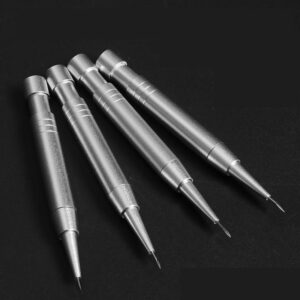 It is a modified version of the FUE technique. The first stage of the surgery is almost no different. Hair follicles are extracted from the donor area. They are placed in a solution containing biotin and nutrients to preserve their viability.
It is a modified version of the FUE technique. The first stage of the surgery is almost no different. Hair follicles are extracted from the donor area. They are placed in a solution containing biotin and nutrients to preserve their viability.
The next stage is the introduction of grafts into the area of baldness. However, unlike the usual procedure of hair transplantation FUE, a modified technique involves a special tool – an automatic implanter CHOI. Externally, it resembles a pen. The main feature of the CHOI pen is that it allows direct transplantation without preliminary opening of channels in the scalp.
Collected grafts are placed in the implanter and transplanted to the area of baldness. About 3-4 CHOI pens are used at a time. 3 specialists perform the procedure. While the leading specialist performs the transplant, assistants load the other implanters. This helps to speed up the hair transplant procedure.
Using an implanter allows the follicles to stay in the external environment for a shorter period, which ensures better engraftment and subsequent hair growth. Another advantage of the CHOI pen is that during transplantation, the graft is protected on all sides by the walls of the hollow needle. This reduces the number of damaged bulbs and results in thicker hair.
The hollow needle of the CHOI pen has a diameter of 0.5 to 1.5 mm. This allows the surgeon to implant follicles with great precision. In addition, the implanter helps to set the growth direction and angle of the hair, which ensures a natural look after transplantation.
How can the transplant result be improved?
After the DHI procedure, platelet-rich plasma therapy (PRP therapy) is performed. This technique not only strengthens the grafts that have already been transplanted but also reduces the loss of the remaining hair, generally improving the transplant outcome. It involves an injection of platelet-rich plasma into the scalp. It is derived from the patient’s own blood. It is a very effective method of treating baldness. That is why some Turkish clinics, particularly Istanbul Aesthetic, have included it in their standard transplant package. For best effect, PRP therapy should preferably be repeated in the 2nd and 3rd months after transplantation.
What is the price of a hair transplant?
If we talk about the cost of a hair transplant using the DHI method, it is usually 150 euros more expensive than using the FUE technique. However, the price difference is well justified by the advantages of DHI, such as a high density of hair, fast recovery and a more natural result.
Hair transplantation: after the procedure
The recovery process after hair transplant procedures such as FUE and DHI is quick and relatively painless. In general, the rehabilitation period takes 10-14 days. Because DHI is a less traumatic technique, recovery is faster.
Scalp care tips after a hair transplant procedure
Tips for post-operative care depend on the initial condition of the scalp, the method of transplantation, the number of grafts transferred, and other factors. Patients are most often advised to:
- Avoid traumatizing the scalp. Avoid touching the transplant area.
- Two days after surgery, to rest in a hotel, observing bed rest in a semi-recumbent position.
- Sleep on your back with a bolster pillow under your neck for two nights after surgery.
- You can take painkillers and antibiotics that your doctor prescribes to reduce discomfort and speed healing.
- After the transplant, the doctor will provide details on how to wash your hair correctly and provide care products. You will need to wash your hair with special cosmetics for 15 days.
- After 10 days, the crusts should come off. During this period, it is necessary to consult a doctor. If it is impossible to do this in person, you can send a photo of the scalp. This is necessary for the doctor to assess how the healing is going visually and, if necessary, to give additional recommendations.
 To avoid unpleasant emotions, patients should know that transplanted hair falls out. This is a normal process. It occurs because, during transplantation, the follicles are temporarily deprived of blood supply. Hair loss begins a week after the procedure and lasts up to 1.5 months. Only in a very small percentage of patients, the transplanted hair does not fall out, but continues to grow. It is important to note that the process of hair loss or its absence does not affect the final result because the bulbs remain in place.
To avoid unpleasant emotions, patients should know that transplanted hair falls out. This is a normal process. It occurs because, during transplantation, the follicles are temporarily deprived of blood supply. Hair loss begins a week after the procedure and lasts up to 1.5 months. Only in a very small percentage of patients, the transplanted hair does not fall out, but continues to grow. It is important to note that the process of hair loss or its absence does not affect the final result because the bulbs remain in place.
Transplanted follicles pass from the resting phase to the growth phase after about 3-4 months. Active hair growth begins, and gradually, their shaft thickens. After about 9-12 months, the patient can fully appreciate the new hairstyle.
Thus, the process of hair loss after the hair transplant should not be of concern if you follow the post-operative care tips. After a while, the balding areas will grow thick, healthy and beautiful hair.
How much does a care package after a hair transplant procedure cost?
Prestigious Turkish clinics specializing in hair transplant procedures, such as Istanbul Aesthetic, Cosmedica, and Turkeyana, practice an individual approach to each patient. The care advice is personalized.
The aftercare package includes personalized recommendations as well as medications and cosmetics necessary for a quick and effective recovery after a hair transplant procedure. Following the doctor’s instructions and using professional scalp and hair care products helps to reduce the risk of complications and obtain excellent aesthetic results.
In leading Turkish hair transplant centres, the cost of this package is included in the treatment price. In some clinics, it also includes:
- airport transportation;
- pre- and post-operative consultations with a hair transplant specialist and sometimes a dermatologist;
- accommodation in a comfortable hotel;
- plasma therapy (a method that stimulates hair growth).
If this basic service is not included in the standard hair transplant package, the Beauty by Experts Medical team will provide it for you. We will arrange additional services for you as soon as possible, such as airline reservations, VIP suites or translation assistance.
What is the best hair transplant procedure?
 When discussing which hair transplant procedure is the best, you should focus on the initial condition of the scalp and the patient’s expectations. The FUE technique is more suitable for people with a severe degree of baldness. This approach allows for more grafts to be transplanted and, therefore, covers more extensive areas of thinning hair.
When discussing which hair transplant procedure is the best, you should focus on the initial condition of the scalp and the patient’s expectations. The FUE technique is more suitable for people with a severe degree of baldness. This approach allows for more grafts to be transplanted and, therefore, covers more extensive areas of thinning hair.
The DHI technique is better suited for patients under 35 with moderate baldness. Ideal candidates for this hair transplant procedure are people who must reduce the hairline (remove bald spots) and make the temples or the top of the head thicker. Up to 4000 grafts can be transplanted in one session with DHI, and up to 6000 grafts with the FUE method.
This is general information. However, each person is different. Therefore, only a specialist can say exactly which hair transplant procedure is the best in a particular case after a detailed assessment of the scalp condition.
The Beauty by Experts Medical team will help you choose the right specialist and clinic in Turkey that meets your needs and wishes. Cooperation with us allows you to get several privileges, including safe travel, maximum level of comfort, and full transparency regarding the cost of treatment.
What is the cost of a hair transplant?
 If you want to receive quality medical care for hair transplantation but also care about the financial side of the issue, the best destination for you is Turkey. The average price of an all-inclusive package in this country ranges from €1650 to €4000. This is much lower than in Europe, the UK, Canada and the USA, where the cost of a hair transplant procedure can start from €5000.
If you want to receive quality medical care for hair transplantation but also care about the financial side of the issue, the best destination for you is Turkey. The average price of an all-inclusive package in this country ranges from €1650 to €4000. This is much lower than in Europe, the UK, Canada and the USA, where the cost of a hair transplant procedure can start from €5000.
In terms of quality of services, clinics in Turkey are not inferior to the leading medical centres of developed countries. Local doctors use modern hair transplantation procedures and offer a high level of service. In addition, hair restoration in Turkey can be combined with an excellent vacation on the magical sea beaches of this country.
Leave a request on the website to find out exactly how much you can expect to pay for hair transplantation in Turkish clinics. A doctor-coordinator will contact you immediately and provide all the necessary information. We will select a clinic and a doctor for you, organize an online consultation with the selected specialist, and do everything possible to make your treatment as effective and safe as possible.
By contacting us, you can be sure that you will not face inadequate price changes when you arrive at the clinic. We also guarantee that the doctor will perform the surgery you have chosen. Beauty by Experts Medical does not charge for their services. You pay for the best hair transplant procedure at the clinic’s cash register.
Sources:
- https://www.oaepublish.com/articles/2347-9264.2017.86
- https://academic.oup.com/asj/article/33/1/128/209891
- https://emedicine.medscape.com/article/839753-overview?form=fpf
- https://www.healthline.com/health/hair-transplant


